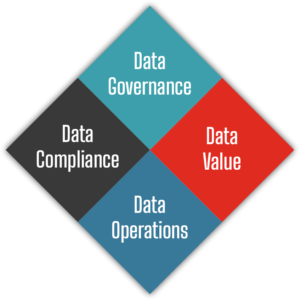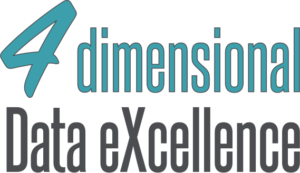 |
 |
|---|
How 4dDX Works
Before reading this, you’ll find it useful to start with an overview.
How 4dDX Works
4dDX works by laying out real-world definitions of how data capabilities should ideally perform. Each definition is presented in the form of objective statements, which a business uses to target and measure the performance of its data capabilities.
4dDX defines data capabilities at three levels of detail:
| Level | Description |
|---|---|
| 1: Dimensions | One of the four categories of data capabilities in 4dDX. |
| 2: Capabilities | A specific data capability within a dimension. |
| 3: Criteria | One of three types of criteria applied to each data capability. |
The three types of capability criteria, are:
- Defining criteria, which specify the content and configuration of the capability.
- Operating criteria, which specify how the capability should be deployed and managed.
- Measurement criteria, which specify how to monitor the performance of the capability.
Across all of its 4 dimensions, the 4dDX framework defines 21 individual capabilities and 190 specific criteria. One example of each these is shown below.
| Level | Example |
|---|---|
| 1: Dimension | Data Value (1 example of 4)
‘Data is a high value strategic asset, fulfilling a prominent role in the business’s overarching strategy, and is measurably driving achievement of the business’s goals‘. |
| 2: Capability | Data Science and Analytics (1 example of 21)
‘Through the application of data science, visualisation and analytics, data provides the business with accurate and relevant insights and intelligence, which informs and drives the effectiveness of business actions and decisions‘. |
| 3: Criteria | Definition (1 example of 190)
‘The business shares an agreed understanding of what KPIs, OKRs and other metrics are appropriate for measuring the business’s performance‘. |
The entire content of the 4dDX framework is published in two document formats.
- An online Miro board, providing a highly visual presentation of all of the capability definitions and their hierarchy across the three levels of detail.
- A spreadsheet, providing an interactive record of all of the capability definitions which can be easily filtered and sorted.
Both of these documents are available by selecting ‘4dDX Framework PDF’ or 4dDX Framework Spreadsheet’ in your client portal.
The 4dDX framework also comes to life in an online data capability maturity assessment, which uses all of the 21 capability statements and 190 criteria to powerfully assess data capability maturity in a way that is robust, actionable and easily repeatable. If you’re using the assessment tools, you’ll find them by selecting ‘Data Capability Maturity Assessment’ in your client portal.
How to Benefit From 4dDX
The 4dDX framework is effective in maximising data value, when it is applied in the following ways.
| Benefit | 4dDX Method |
|---|---|
|
|
|
|
|
|
|
|